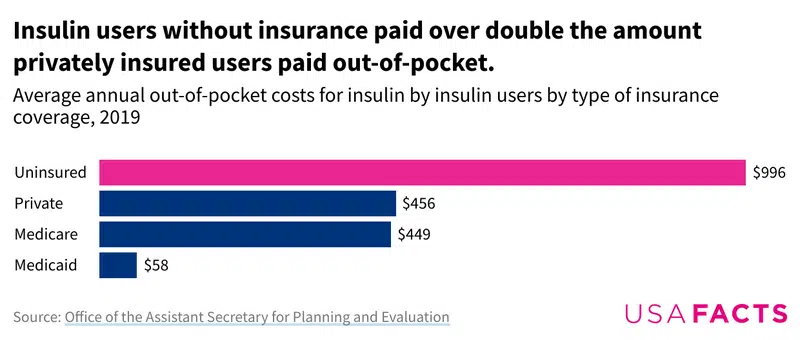
How many people are diagnosed with diabetes in the US? Plus: which states have the highest and lowest rates of diabetes.
Updated on Sat, April 15, 2023 by the USAFacts Team
Home / Health / Articles / A cap on insulin costs benefits millions of Americans with diabetesMore than 37 million Americans have diabetes and about 7.4 million adults take insulin, a hormone that regulates glucose and is used to treat diabetic patients.
But insulin can be expensive for some patients across the United States. Capping costs has become a central issue for the Biden administration.
The price of insulin varies widely, depending on one’s health insurance coverage, the brand of insulin, and the type or dosage of insulin they need. In extreme cases, a person with diabetes can spend over $1,000 per month, according to a US Senate Finance Committee report.
For example, a Novo Nordisk insulin pen cost $462 in 2019. That means a diabetic patient who needs four insulin pens per month would pay $1,848 monthly.
Of the Americans who take insulin, 52% are on Medicare, 33% are privately insured, 12% are on Medicaid, and 2% are uninsured. Those without health insurance are the most exposed to out-of-pocket costs. According to a recent report from the US Department of Health and Human Services (HHS), people with diabetes enrolled in Medicare or private insurance spent an average of $452 out of pocket for a year’s supply of insulin in 2019. Uninsured insulin users, however, paid more than twice as much out of pocket on average ($996) for insulin.

Simply needing insulin comes with a hefty price tag. The Department of Health and Human Services estimated that total healthcare spending, or the sum of all out-of-pocket payments and insurance coverage, was $446 billion for all diabetes patients in 2019. However, people with diabetes who took insulin that same year spent an estimated $202 billion on healthcare. That’s almost half (45%) of the total spending for all diabetes patients, even though people on insulin account for 27% of the diabetic population. That means people with diabetes who take insulin spend 2.2 times more annually on total health expenditures than those who don’t.
Those who are uninsured or have poor coverage may try to save money by rationing their insulin supplies, with an estimated 1.3 million Americans with diabetes saying they skipped or underused vials last year.
However, not taking — or not taking enough — insulin can have serious and sometimes fatal consequences. Diabetes is the eighth leading cause of death in the United States, and having diabetes can increase a person’s risk for severe COVID-19 symptoms, cause chronic kidney disease and kidney failure, and present other comorbidities. CDC research has shown that adults 50 or older with diabetes die 4.6 years sooner on average than those without diabetes.
President Joe Biden signed the Inflation Reduction Act into law last August. The act includes a provision that caps Medicare beneficiaries’ monthly out-of-pocket insulin costs at $35. The price cap took effect on January 1, 2023.
Eli Lilly, the country’s largest insulin manufacturer, announced in March 2023 that it would cap the out-of-pocket price of its insulin at $35 a month, cutting the cost by 70%.
If the insulin cost provision in the Inflation Reduction Act had been enacted in 2020, about 1.5 million seniors on Medicare would have saved an average of $500 on insulin for the year, according to the HHS.
Diabetes disproportionately affects communities of color. According to the Centers for Disease Control and Prevention (CDC), in 2018–2019, Native Americans and Black Americans had the highest rates of diagnosed diabetes in adults ages 18 and up, at 14.5% and 12.1%, respectively. About 11.8% of Hispanic or Latino American adults had diabetes, followed by 9.5% of Asian Americans. White Americans had the lowest diabetes rate at 7.4%.